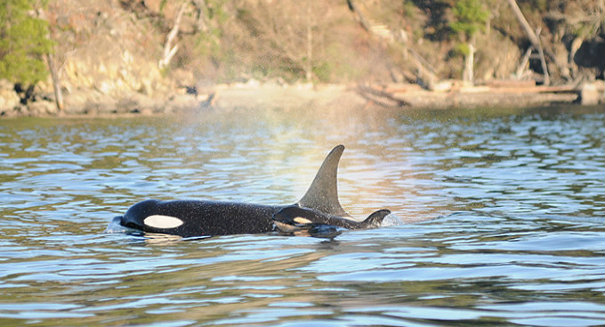
Maternity of baby orca is still unknown
It’s tough being a killer whale, especially for the group known as J-pod, whales found in southern Canadian waters who became endangered in 2005. After a two-year lull with no new births, they welcomed a new member, known as J50, on or about December 20. After weeks of speculation as to the nature of the birth and whether or not the calf would survive, scientists at the Center for Whale Research in Washington state have confirmed that J50 is a baby girl.
“We are working in coordination with researchers from Canada’s Department of Fisheries and Oceans (DFO) to obtain facts and photographs that will help solve the matrilineal situation, but the sex of J50 is now confirmed to be female,” the Center said in a release.
The specifics surrounding her birth are a but mysterious. For starters, she may have been birthed by a 42 year old whale named J16 – an outlier in terms of age for producing offspring. J50 also appears to have some tooth-shaped markings on her dorsal fin, which indicate that the birth may have been difficult and another whale may have helped pull her out (who knew whales could do that?).
Despite the peculiarities, J50 appears to be healthy and energetic.
It’s also possible that J50 is the daughter of J36, herself the 16 year old daughter of J16. That would make a lot more sense in terms of breeding age, and scientists have hoped that she would produce a calf soon. Identifying exact parentage can be tricky with whales, they say.
“Sometimes it takes a few encounters and some time to sort these things out because these whales are very caring for one another, and baby-sitting is not unusual, especially with grandmothers,” the Center for Whale Research said in the release.
One concern is that calves typically spend their first two months without leaving their mothers’ side. And yet, J36 has not been seen since J50 was noticed in the pod. The worst-case scenario would be that J36 died giving birth, and J50 is being raised by her grandmother, who likely cannot produce milk.
Any growth for the endangered J-pod is a welcome sight. J50 brings their numbers up to 78, but that still represents a 30-year low. 2014 was a rocky year for J-pod, and the successful birth is something of a relief. They lost one male and two females, one of whom was carrying a near-full term calf.
is a